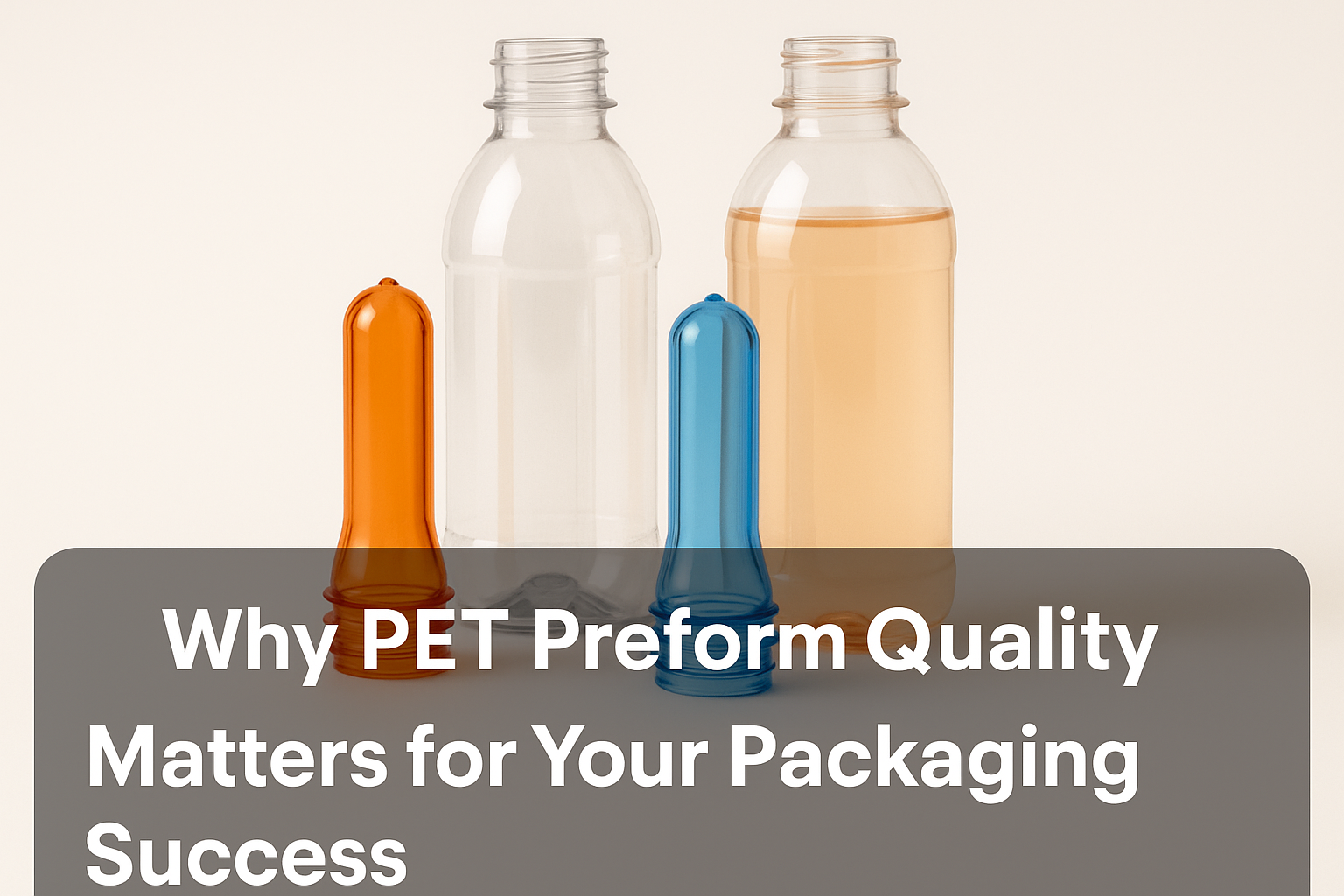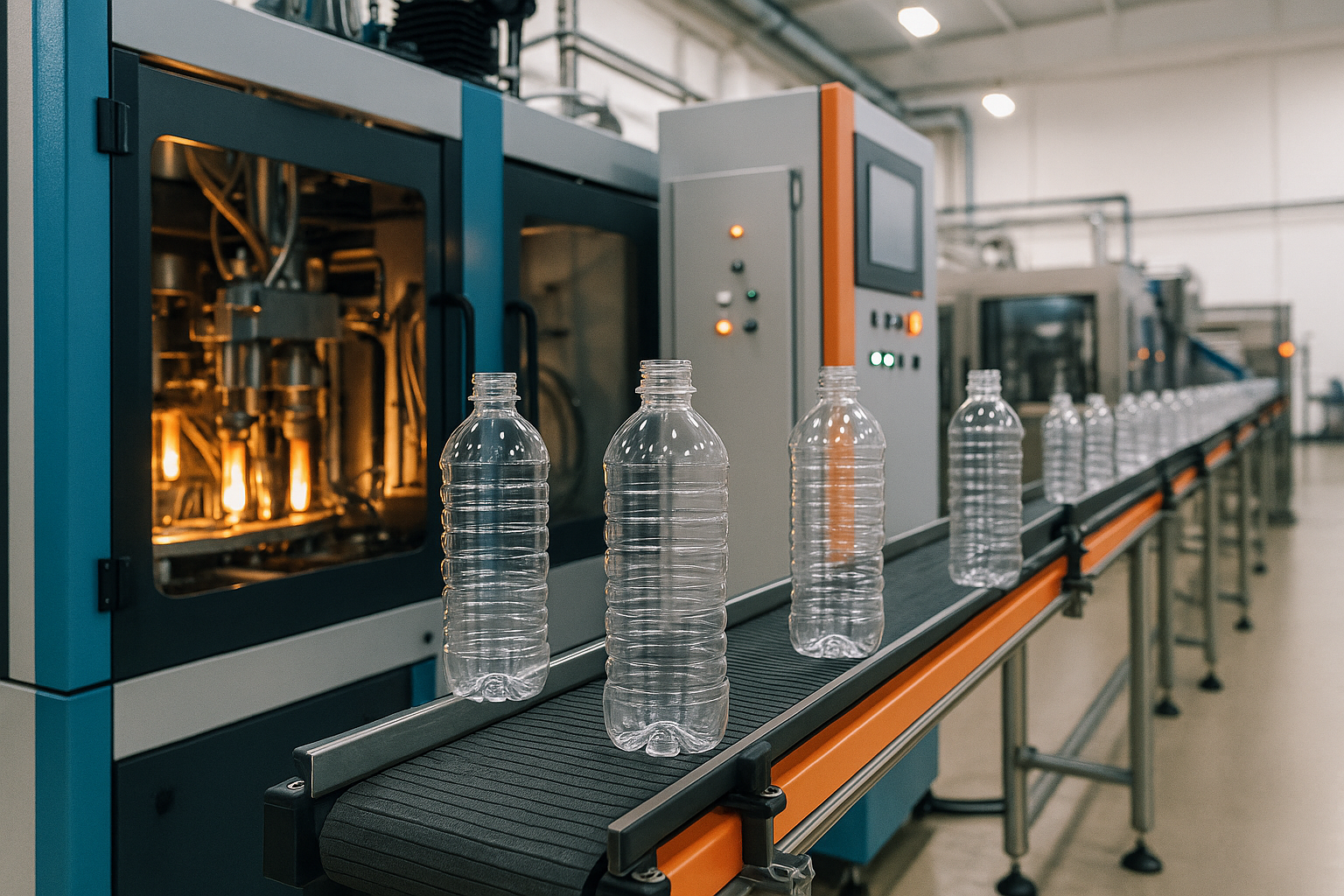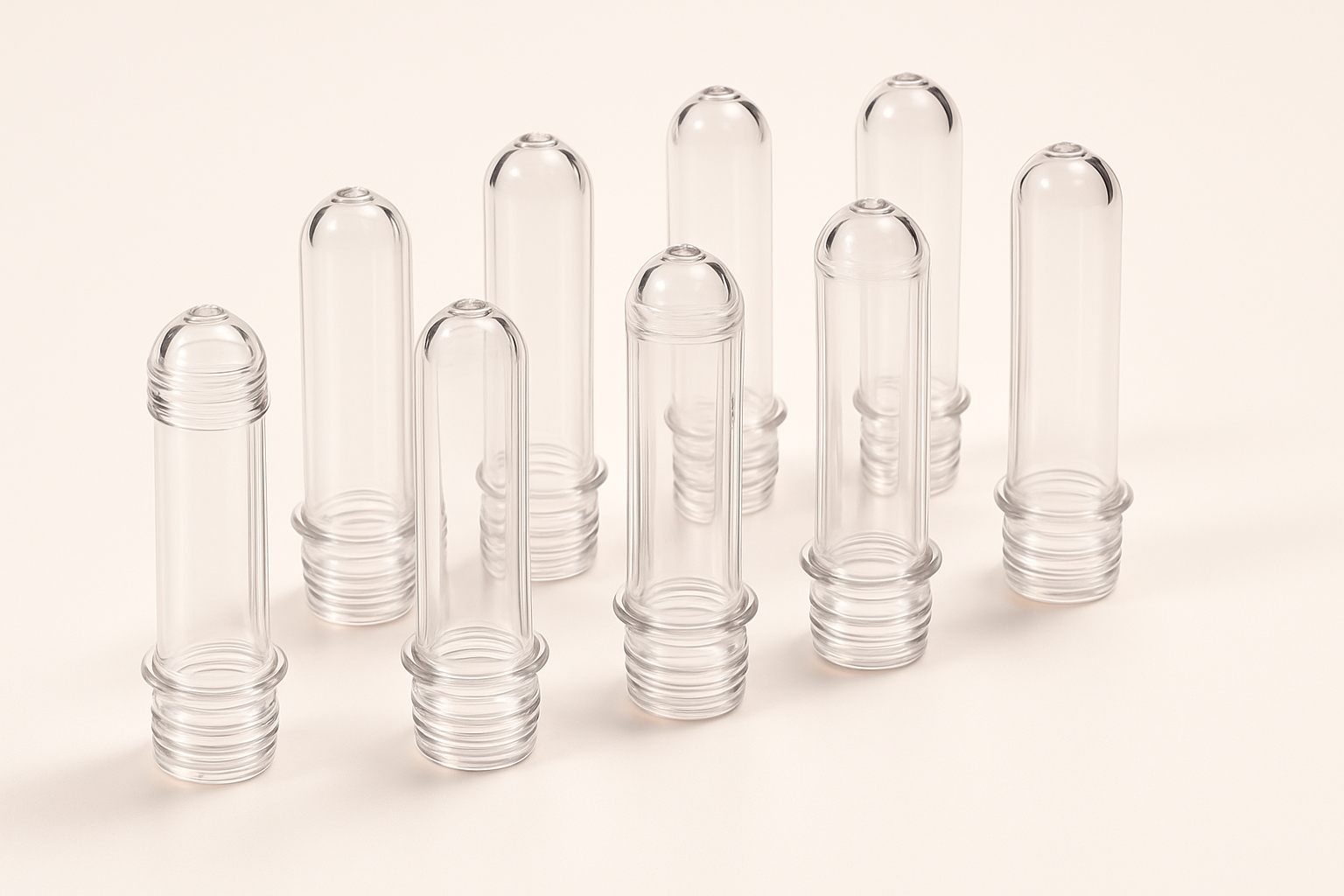Why PET Preform Quality Matters for Your Packaging Success

You might be wondering, “Why should I spend so much time thinking about PET preforms?” After all, they’re just small plastic tubes, right? But here’s the truth: these seemingly simple items are the silent backbone of your entire packaging operation. Their quality directly impacts everything from your production line efficiency to your brand’s reputation in the market.
In India’s competitive consumer goods landscape, consistent packaging quality isn’t just a nice-to-have; it’s a must-have. We know that every perfect PET bottle begins its journey as a perfect preform. If that foundation is weak, the entire structure is at risk, jeopardizing your success.
The Hidden Costs of Poor PET Preform Quality
Using low-quality PET preforms might seem like a small saving upfront, but trust us, it often leads to colossal problems down the line. These issues can aggressively eat into your profits and severely damage your business in many unforeseen ways. Have you ever considered the true cost?

Production Headaches and Inefficiency
- High Scrap Rates: Imagine the frustration of seeing your production line generate misshapen, burst, or defective bottles during the stretch blow molding process. This isn’t just waste; it’s a direct hit to your material budget and profitability.
- Frequent Line Stoppages: Inconsistent preforms are notorious for causing machines to jam or churn out faulty bottles. Your production line grinds to a halt repeatedly, wasting invaluable time and drastically reducing your daily output. The clock is always ticking, right?
- Increased Energy Use: Inconsistent preforms force your blowing machines into constant adjustments, leading to higher energy consumption as they struggle to compensate. This directly inflates your utility bills, chipping away at your bottom line.
Financial Losses That Add Up
- More Material Waste: You’ll inevitably need more preforms to achieve your desired number of good bottles, meaning you’re buying far more raw material than genuinely necessary. That’s money literally being thrown away.
- Higher Labour Costs: Your team will likely spend significant extra time sorting out bad preforms or defective bottles. This additional, often avoidable, manual work drastically inflates your operational expenses.
- Delayed Shipments: Production delays don’t just push back your timelines; they can cause you to miss crucial delivery deadlines. This, in turn, can lead to costly penalties and even the devastating loss of future orders from your valued clients. Can your business afford that risk?
Compromised Product and Packaging Integrity
- Ugly Bottles: Defects such as haze, streaks, or inconsistent color can instantly make your bottles appear cheap and unprofessional. This immediately puts off discerning customers, who often judge a product by its packaging. First impressions truly matter, don’t they?
- Weak Bottles: Poor quality can lead to critical structural weaknesses like thin spots or cracks. These compromised bottles might rupture during transport or on the retail shelf, potentially spoiling your entire product batch and creating a messy nightmare.
- Shorter Shelf Life: For many sensitive products, packaging must provide a robust shield against oxygen or moisture. If preform quality compromises this vital “barrier property,” your product’s shelf life could drastically shorten, leading to spoiled goods and lost revenue.
Damage to Your Brand Reputation
Inconsistent or faulty packaging directly, and often severely, reflects on your brand’s integrity. When customers encounter bottles with visible defects, their immediate perception is that your product inside must also be of low quality. This rapidly escalates into complaints, damaging negative reviews, and a devastating loss of consumer trust. In severe scenarios, it can even trigger costly product recalls – a truly expensive and catastrophic blow to your brand’s image and market standing. We’ve all seen brands struggle to recover from such setbacks.
What Makes for Superior PET Preform Quality?
So, what exactly should you be looking for to avoid these costly pitfalls and ensure your packaging shines? Understanding what goes into a truly superior preform helps you choose the absolute best for your specific needs. It’s far more than just how it looks; it’s about precision and performance.

1. Visual Perfection
A good preform should be perfectly clear and free from any visible flaws. Look for:
- Clarity: It must be perfectly transparent, absolutely free from any haziness or cloudiness.
- No Foreign Particles: You should see no black specks, dirt, or dust trapped within the plastic – a clear sign of poor manufacturing.
- Gate Quality: The small point where the plastic was injected (often called the ‘gate’) must be neat and clean. There should be no excessive plastic stringing or unsightly cracks around it, which can indicate structural weaknesses.
- No Bubbles or Voids: Any air bubbles or voids trapped inside the plastic will inherently weaken the preform and are a guaranteed recipe for defects in the final bottle.
2. Precise Measurements
Every preform must be exactly the same size and weight. Even small differences can cause big problems in bottle manufacturing.
- Weight Consistency: Each preform should weigh the same. This ensures uniform wall thickness in the final bottle.
- Neck Finish: The top part where the cap fits is absolutely critical and must be flawless. Even a tiny deviation can lead to frustratingly leaky bottles, spoiling your product and reputation.
- Overall Dimensions: The length and diameter demand exact precision. This ensures the preform heats evenly and blows into the perfectly correct bottle shape, every single time.
3. Intrinsic Viscosity (IV) and Acetaldehyde (AA) Content
Now, let’s dive into a couple of seemingly technical terms – Intrinsic Viscosity (IV) and Acetaldehyde (AA) content – that are surprisingly crucial for your product’s safety and taste. Don’t let the names intimidate you; we’ll break them down:
- Intrinsic Viscosity (IV): Think of IV as the plastic’s “strength” or its inherent backbone. It scientifically measures the length of the plastic chains. A high and consistent IV ensures the plastic is robust enough for the rigorous bottle-blowing process and that your final bottle will possess excellent mechanical properties and durability.
- Acetaldehyde (AA): This is a chemical compound that can regrettably form in PET during processing. High AA levels are a serious concern because they can impart an undesirable, slightly plastic-like flavor to bottled water or beverages. For any food and beverage packaging, keeping AA levels extremely low is absolutely critical for maintaining impeccable product taste and ensuring consumer safety. No one wants their drink to taste like plastic, do they?
4. Crystallinity and Thermal Stability
The plastic’s internal structure (known as crystallinity) and its precise reaction to heat (thermal stability) are absolutely key. Superior preforms heat up predictably and uniformly, every single time. This critical consistency ensures the material stretches evenly and perfectly during blow molding, culminating in a strong, beautifully clear, and flawless bottle.
| Specification | Unit | Typical Range/Standard |
|---|---|---|
| Material Grade | – | Virgin PET Resin (e.g., IV 0.80 – 0.84 dL/g) |
| Intrinsic Viscosity (IV) | dL/g | 0.78 – 0.86 (application-dependent) |
| Acetaldehyde (AA) Content | ppm | < 3.0 ppm (Food Grade) |
| Preform Weight Consistency | % | ± 0.2g tolerance (typical) |
| Neck Finish Standard | – | PCO 1810, PCO 1881, 30/25, BPF, Alaska |
| Wall Thickness Uniformity | mm | ± 0.1 mm or < 5% variation |
| Clarity | Haze % | < 1.0 % (typical) |
| Color | L*a*b* | Specified (e.g., L>90, a<1, b<2) |
| Moisture Content | % | < 0.005 % |
| Crystallinity | % | Targeted for optimal stretch behavior |
How to Ensure Top-Tier PET Preform Quality for Your Business
So, how can you guarantee that your packaging operation consistently delivers top-tier quality and avoids all these potential pitfalls? Achieving truly consistent, high-quality packaging is indeed a team effort. It critically starts with your astute choice of suppliers and seamlessly continues through your own meticulous production processes. Let’s explore how.
1. Partner with Reputable Suppliers
This is, without a doubt, the single most crucial step in safeguarding your packaging quality. We strongly advise you to look for suppliers who:
- Have Certifications: Always check for robust international quality standards, such as ISO 9001, and critically, food safety certifications if your product demands it.
- Show Transparency: A truly reputable supplier will be completely open and transparent about their entire manufacturing process and stringent quality control measures. They have nothing to hide.
- Offer Technical Support: They should be readily available to assist you promptly if you encounter any issues and provide comprehensive technical data and expertise.
- Ensure Traceability: Can your supplier reliably track each batch of preforms back to its original raw material source? This crucial capability is indispensable for rigorous quality control and swift problem-solving if an issue ever arises.
2. Implement Robust In-House Quality Control
Even with a great supplier, it’s wise to have your own checks. This includes:
- Incoming Inspection: Implement immediate, thorough checks of preform samples as soon as they arrive at your facility.
- Using Testing Equipment: Deploy appropriate tools, such as advanced dimensional scanners or even reliable simple gauges, to meticulously verify key parameters. This gives you peace of mind.
- Statistical Process Control (SPC): Leverage data-driven insights through SPC to rigorously track quality trends. This proactive approach empowers you to spot potential problems and rectify them long before they escalate into major, costly issues.
3. Optimise the Injection Molding Process
For those directly involved in PET preform manufacturing, meticulous control over every aspect of the process is absolutely vital. This unequivocally means:
- Consistent Temperatures: Maintaining incredibly stable melt temperatures and precise cooling times without fluctuation.
- Proper Mold Maintenance: Ensuring molds are impeccably clean and perfectly maintained is paramount to preventing defects and guaranteeing flawless output.
- High-Grade PET Resin: Always starting with the highest-grade PET resin available is not just fundamental; it’s the bedrock of superior preform quality. Don’t compromise here!
Real Case Studies: The Impact of PET Preform Quality
Case Study 1: Leading Beverage Manufacturer Optimizes Production
A prominent Indian beverage company was struggling with high scrap rates, averaging 7-9%, and frequent line stoppages on their stretch blow molding lines, leading to missed production targets. Upon a detailed analysis, they identified inconsistent PET preform quality, particularly in weight and dimensions, as the root cause. They partnered with a certified premium PET preform manufacturer who provided preforms with stringent quality controls, including precise weight consistency and dimensional accuracy. Within three months, the beverage company reported a significant reduction in scrap rates to less than 2%, increased line efficiency by 15%, and achieved a 10% reduction in energy consumption due to fewer machine adjustments. This resulted in annual savings exceeding ₹2 crores.
Case Study 2: Pharmaceutical Company Ensures Product Integrity and Compliance
A pharmaceutical giant, packaging sensitive oral suspensions, faced recurring issues with product discoloration and a slight metallic off-taste reported by consumers. Initial investigations pointed to potential material degradation in the packaging. After conducting extensive tests, it was discovered that the existing PET preforms had elevated Acetaldehyde (AA) levels and inconsistent barrier properties. The company switched to a specialized preform supplier known for ultra-low AA content and enhanced oxygen barrier properties. This change completely eliminated product discoloration and off-taste complaints, ensuring product efficacy and compliance with strict pharmaceutical standards. The shift not only protected their brand reputation but also averted potential costly product recalls, estimated to save them over ₹5 crores in potential damages and lost sales.
Case Study 3: FMCG Food Brand Achieves Sustainable Lightweighting Goals
A fast-moving consumer goods (FMCG) brand aimed to reduce the plastic content in its edible oil bottles by 15% as part of its sustainability initiative. However, initial attempts with standard preforms resulted in bottles lacking structural integrity, experiencing deformation during transport, and offering reduced shelf life. They collaborated with a PET preform manufacturer specializing in lightweighting solutions. By utilizing preforms made from advanced PET resin grades with superior intrinsic viscosity (IV) and exceptional thermal stability, the brand successfully produced bottles that were 15% lighter without compromising strength, clarity, or barrier properties. This initiative led to an 8% reduction in raw material costs per bottle and a notable decrease in their carbon footprint, while maintaining an excellent shelf presence and product protection.
Quality in the Age of Sustainability
The world is rapidly accelerating its shift towards more sustainable packaging solutions, and here’s where PET preform quality truly plays an even more crucial role.
- rPET Preforms: Utilizing recycled PET (rPET) is, undoubtedly, a fantastic step for environmental responsibility. However, rPET can inherently be trickier to process and unequivocally demands even stricter quality control measures to flawlessly maintain clarity, strength, and critical food safety standards. It’s a challenge worth getting right.
- Lightweighting: Reducing the amount of plastic in each bottle is a paramount sustainability goal. Only the highest-quality preforms are absolutely essential for successfully making thinner, lighter bottles without compromising their vital strength or critical performance. Unwavering precision in preform manufacturing truly unlocks these crucial weight reductions, benefiting both your costs and the planet.
Invest in Quality, Secure Your Success
Ultimately, PET preform quality isn’t just a mundane technical specification; it’s a profound strategic investment. It proactively protects your hard-earned profits, dramatically enhances your brand’s reputation, and unequivocally ensures your valuable products reach customers in absolutely pristine condition. By relentlessly focusing on quality from the very start, you aren’t just making superior bottles; you’re actively building a robust, far more reliable, and undeniably successful packaging operation that stands the test of time.
So, choose your preform supplier with utmost wisdom. Invest diligently in your in-house quality control processes. Your entire packaging success, and indeed your brand’s future, truly depends on it.

